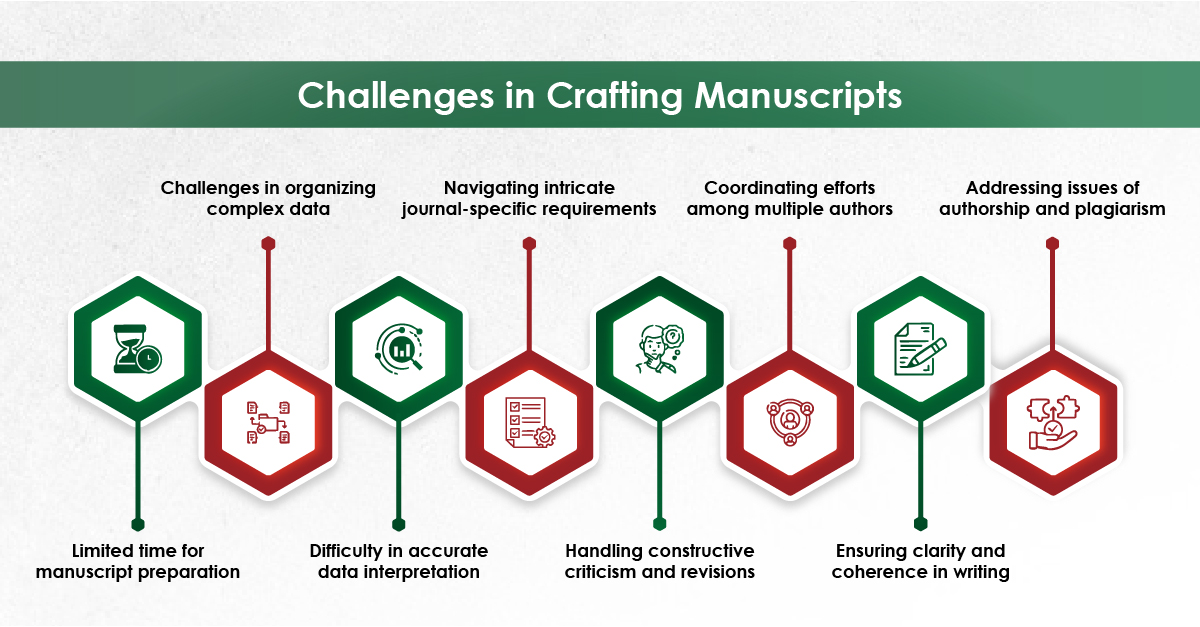Scientific advancement in academia depends greatly on research, but its true value lies in publishing and sharing findings with the broader scientific community. Transforming raw data into a refined, publishable manuscript can be challenging and requires significant focus and effort. This blog provides a comprehensive roadmap to assist researchers in effectively transforming their research findings into manuscripts ready for publication.
Recognizing the Significance of Your Data
Before beginning the writing process, researchers should reflect on their findings and consider the following questions:
- What novel insights does the study provide? This helps identify the critical findings that distinguish the research from the existing literature.
- How does it advance the research area? This question highlights how the study’s findings contribute to advancing current practices, knowledge, and understanding in the respective field.
- How does it address existing knowledge gaps? This helps determine to what extent the study addresses previously unresolved questions in the research area.
Knowing the answers to these questions helps organize the manuscript efficiently, highlight its significance, and ensure its relevance to the field.
Read More: AI-Driven Insights: Discovering New Research Opportunities in Medical Science
Selecting a Journal and Target Audience
Choosing the right journal and determining the target audience are crucial steps in manuscript preparation. The journal selection can impact the manuscript’s focus, length, and style. Key factors to consider when selecting a journal include:
- Impact Factor: Journals with higher impact factors often have more stringent submission requirements.
- Journal Scope: The research should align with the journal’s focus. For example, choosing a specialized journal for research in a particular therapeutic area.
Understanding a journal’s guidelines can reduce the likelihood of rejection and save time during the submission process.
Addressing Ethical Considerations
It is critical to follow ethical standards when writing an acceptable manuscript. This involves getting the required approvals to conduct the study, securing informed consent from participants, and ensuring data privacy requirements are upheld.
Common Challenges in Manuscript Preparation
Recognizing potential challenges can significantly improve the manuscript preparation process. Some common challenges include:
- Time Constraints: Balancing ongoing research with personal commitments can limit the time for manuscript writing.
- Data Organization: Presenting complex data effectively requires careful organization and a strategic approach.
- Statistical Analysis: Conducting and presenting statistical analyses accurately can be difficult, especially for those without a strong statistical background.
- Formatting Requirements: Different journals have specific formatting and submission guidelines that can be tricky to navigate.
- Peer Review Process: The peer review process can feel daunting, as constructive feedback often necessitates significant revisions.
- Writing Skills: Difficulty in clearly conveying ideas can affect the overall quality of the manuscript.
- Ethical Considerations: Ensuring compliance with ethical standards, including proper citation practices, is crucial but challenging.
- Collaboration: Coordinating with co-authors and aligning different writing styles can make it difficult to create a cohesive manuscript.
Identifying these challenges early can help researchers streamline the manuscript preparation process and improve their chances of successful publication.
Organizing the Data
Effective organization of the raw research data is a critical aspect of manuscript preparation. Careful organization of the data before starting the writing ensures clarity and coherence. This can be achieved by:
- Analyzing findings and identifying key points.
- Grouping similar findings with a clear rationale.
- Creating a logical flow to present the data.
- Using visual aids to enhance clarity.
- Avoiding overloading the manuscript with unnecessary visuals.
Crafting a Compelling Title and Abstract
The title and abstract are critical elements that are often the first things noticed by potential readers and journal editors. A clear, concise title, combined with a well-crafted abstract, can significantly influence the readability and appeal of the full paper. The abstract should:
- Clearly define the research problem.
- Briefly describe the methods and key findings.
- Highlight the significance of the work.
Structuring the Manuscript
Most scientific manuscripts follow the Introduction, Methods, Results, and Discussion (IMRaD) format. This structure ensures logical organization and makes the paper easy for readers to follow.
- Introduction: Provides context by summarizing the research background, stating the research question, and outlining the study objectives.
- Methods: Details the study design, including experimental procedures and statistical analyses, ensuring transparency.
- Results: Presents the findings in an organized manner, supported by visuals.
- Discussion: Interprets the findings, compares them with existing research, and discusses limitations and future directions.
Writing Clearly and Precisely
Clear writing is essential for effective research communication. This involves:
- Avoiding jargon and unnecessary abbreviations.
- Being concise and eliminating redundancy.
- Using active voice to enhance readability.
For those who find this challenging, seeking feedback from colleagues or considering professional editing can be beneficial.
Citing Appropriately
Accurate referencing adds credibility to the work. This can be accomplished by:
- Using current and relevant references.
- Following the specific citation style required by the target journal.
- Focusing on key studies directly related to the research, while avoiding over-citation.
Revising and Editing
It is beneficial to revise the draft once it has been completed. Involving colleagues in this process can provide valuable insights and perspectives. This process ensures:
- Refining the clarity and coherence of the manuscript.
- Eliminating unnecessary details or redundancies.
- Double-checking data and citations for accuracy.
Submitting and Navigating the Review Process
After submission, preparing for the peer review process is essential. Reviewers will assess the strengths and weaknesses of the paper and provide feedback. Answering the feedback involves the following:
- Responding clearly to each point raised in the requested revisions.
- Resubmitting the manuscript with all corrections and justifications.
Rejection is a normal part of the academic publication process. Learning from feedback can improve the manuscript for future submissions.
Final Thoughts
Turning research data into a publishable manuscript requires time, effort, and patience. Using appropriate and methodical approaches can make the process more manageable. It is important to remember that every step, from selecting the right journal to refining the writing, helps researchers make valuable contributions to their field.
Want to Simplify Your Publication Process?
Despite the challenges of transforming raw research into a well-structured manuscript, the entire journey — from data analysis to manuscript submission — can be streamlined. Partnering with Turacoz ensures a professional, efficient, and successful publication process. Our experience and expertise in scientific publications can significantly ease the workload and elevate the impact of research. Whether you need assistance with writing, editing, submission, or promotion, the Turacoz team offers tailored solutions to meet your needs. Please contact us at [email protected] to elevate your publication experience.







































